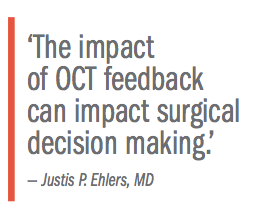Article
Technologic advances integrate OCT into real-time surgeries
Author(s):
Researchers are conducting a prospective, multisurgeon, single-center study to evaluate multiple microscope integrated-prototypes with real-time surgeon feedback.
Take-home message: Researchers are conducting a prospective, multisurgeon, single-center study to evaluate multiple microscope integrated-prototypes with real-time surgeon feedback.
By Michelle Dalton, ELS; Reviewed by Justis P. Ehlers, MD
Cleveland-Microscope integrated intraoperative optical coherence tomography (iOCT) can confirm that surgical objectives of various retina surgeries have been met, said Justis P. Ehlers, MD.
Dr. Ehlers and colleagues are conducting a prospective, multisurgeon, single-center study, the DISCOVER study, to evaluate multiple microscope integrated-prototypes with real-time surgeon feedback, including the Rescan 700 (Carl Zeiss Meditec), the Bioptigen prototype (Leica), and a Cole Eye Institute iOCT System (Cleveland, OH).
Simple solution for presbyopia?
The Rescan 700 is based on the Lumera 700 platform (Carl Zeiss Meditec). The device received FDA clearance in late 2014, and is only one of two devices studied that currently has regulatory clearance in the United States. (The second FDA -cleared device, the iOCT from Optomedical Technologies integrated into the HS Hi-R Neo 900A (Haag-Streit Surgical) was not included as part of this study.)
How the technologies differ
Two of the devices-the Cole Eye Institute iOCT system and the Rescan-utilize a heads-up display system.
The Rescan is a single integrated system, with both the microscope and OCT integrated into one unit.
Next: Advantages, disadvantages
Given the integrative approach, “the microscope head that the surgeon uses is nearly identical to the Lumera 700. The Rescan 700 has a heads-up display with foot pedal control of the OCT beam,” Dr. Ehlers said.
Blog: Pearls for a successful start to your ophthalmic career
At the time of the initial phase of the study, the device was not yet FDA-approved, but the unit evaluated “was very near its final stages of development.”
In contrast to the Rescan system, the Bioptigen and Cole Eye iOCT systems are based on a microscope head add-on that can potentially be fairly universal and system agnostic, Dr. Ehlers said.
The add-on approach has both advantages and disadvantages, he added, noting it’s too early to postulate which approach is best.

Currently, both the Bioptigen and Cole Eye systems use mouse control for the OCT beam and have more limited true real-time visualization.
Utilizing these systems, various OCT engines can also be applied, including deep imaging systems with enhanced range or potentially even swept source OCT, Dr. Ehlers said.
Balancing the positives and negatives of these various approaches “is a key aspect of this ongoing research, such as the enhanced range of visualization compared to increased resolution,” he said.
Cataract surgery benchmarks proposed
Of the 154 cases, 95 (61%) of the cases were preferred by the treating physicians to be visualized with real-time feedback compared with static.
However, the challenges around heads-up display are also apparent in optimizing the overall quality of the image and the specifics around the display of actual OCT data stream, Dr. Ehlers added.
Study details
During year 1 of the DISCOVER study,1 a total of 227 eyes (91 anterior segment cases and 136 posterior segment cases) underwent imaging with the Rescan 700 system. Successful imaging (e.g., the ability to acquire an OCT image of the tissue of interest) was obtained for 224 of 227 eyes.
During lamellar keratoplasty, the iOCT data provided information that altered the surgeon’s decision making in 38%of the cases (e.g., complete graft apposition when the surgeon believed there was interface fluid).
Glaucoma more common in those with lower incomes
In epiretinal membrane peeling procedures, iOCT information was discordant with the surgeon’s impression of membrane peel completeness in 19% of cases (e.g., lack of residual membrane or presence of occult membrane), thus affecting additional surgical maneuvers.
In posterior segment surgery, iOCT impacted 34% of cases (53/154) resulting in changes to the surgical approach in providing a better understanding of the anatomy or clinical situation, including identifying optimal drainage sites, discriminating choroidal from subretinal fluid, performing less surgery/peeling, and identifying full-thickness macular hole.
“Although the impact of true real-time OCT-guided surgical maneuvers is unclear, it appears to becoming more abundantly clear that the impact of OCT feedback can impact surgical decision-making,” Dr. Ehlers said. “One of the important things that we found with these systems in the DISCOVER study that was different from external intraoperative OCT systems was the ability to actually target the areas of interest given the ability to simultaneously visualize the area of interest and perform an OCT scan.”
For example, during surgery “the surgeon could direct any of the systems to scan to various areas of interest during surgery,” he said.
As a result, residual membrane that needed additional peeling was seen in 12/73 cases where the surgeon thought the surgery was already complete. Conversely, the devices confirmed the membrane peel was complete in 16/73 cases where the surgeon thought additional peeling might be necessary.
Next: Surprising, or not?
Surgeons reported that the systems interfered with the surgery in 7% of cases, most frequently due to iOCT/microscope or software malfunction.
“From our perspective, this was not surprising since all of these were prototype systems,” Dr. Ehlers said.
Online vision test causes stir within eyecare community
The study also illustrated areas for improvement and needs for additional development-better software will enable better visualization and image analysis; increased flexibility when tracking an area of interest; improved image quality; and OCT-compatible instrumentation, he said.
Reference
- Ehlers JP, Goshe J, Dupps WJ, et al. Determination of feasibility and utility of microscope-integrated optical coherence tomography during ophthalmic surgery: The DISCOVER study RESCAN results. JAMA Ophthalmol. doi:10.1001/jamaophthalmol.2015.2376 Published online July 30, 2015.
Justis Ehlers, MD
E: ehlersj@ccf.org.
This article was adapted from Dr. Ehlers’ presentation at the 2015 meeting of the American Society of Retina Specialists.




